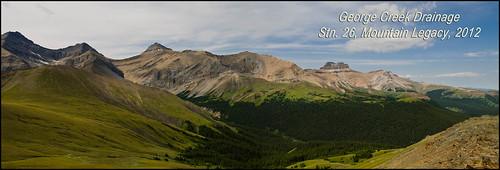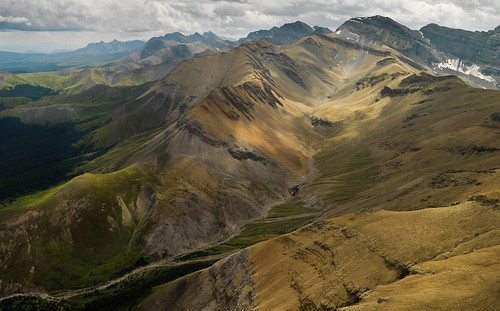At the Grande Cache Visitor’s Center, among the maps and directions I asked for, I also picked up this book: Mountain Weather: Backcountry Forecasting and Weather Safety for Hikers, Campers, Climbers, Skiers, and Snowboarders (2007). Among the first of it’s pages, this bit of wisdom: “Life in high places exists by meteorological consent” (p. 19). For the Willmore and Clearwater regions both, this could not be more true. In no other place have I started my day by looking with anticipation out at the sky, or finished my evening by gazing upwards, curious about what the next day would bring. And even then – the mountains can be surprising!
In the Clearwater, the weather seems to move from the West. Whether it travels straight East, up to the North, or down South, or any combination of these things, depends on the winds. And the winds depend on the temperatures. If it’s hotter, there will be stronger convective currents that can tumble and toss the helicopter. So usually, the winds pick up as the afternoon lengthens.
From our camp, we look West down the Shunda Fire Base Runway, and if we can see a wall of clouds covering one of the lower mountains, that’s bad news for us. We were about 50-60 kilometres away from where our stations start, and a lot can be different, 50-60 kilometres away.
Our days here began a bit slower. We completed one station our first day with Allison, and attempted a second with our fantastic project supervisor Eric joining us in the field, but we realized our hike would take too long, given the time constraints we were under, so we headed back to camp. Here a shot of Eric speaking with Allison, our pilot, with Mary and Jenna goofing around! This was after our calculated retreat from our Station 22:

Eric, Allison, Mary and Jenna by AOX (Alpha-Oscar-Xray), our helicopter! We’re on the Bighorn Ridge. (Photo credit: Heike Lettrari)
Earlier in the day, we had completed our Station 26:
What a station! George Malloch’s 1908 Bighorn Coal Survey is a different beast altogether. As Mary has pointed out: after spending a number of hours with a surveyor’s photos, you start to get inside their head. We have now had numerous stations where George Malloch (or his photography/surveying teams) moved two, or three, or as many as four times at a given station. No cairn. No noticeable feature to mark where he took the photos from. Some new challenges, which we overcame, nonetheless!
Returning to Shunda has been great. Seeing the camp cooks, Shauna and Vinnie, and the camp boss, Tina, was like coming back to friends long-missed. We also got lucky: Allison was our pilot again! Here she is:
We were also joined by our HERO, Rob Watt, former park warden for the Waterton Lakes National Park. What a guy! Encyclopedic with his knowledge, and so humble about sharing his information. We learned that it’s possible to identify tree species from the air: lodgepole pines grow in a thicker mat, and have a slightly brighter green than do their darker green spruce counterparts. Mary suggested the possibility of tracing drainage patterns because of the dark lines of spruce trees we saw along the river ways, flying to our stations. What gorgeous country we were in. Here a few highlights from our day with Rob:

Station 29. Rob, Allison, Jenna and Mary! Walking the expanse of our ridge, looking four our fourth image. (Photo credit: Heike Lettrari)
One of the last things I did before leaving the Mt. Robson Provincial Park last week, was check out the books in the Visitor’s Center. I bought three, including one that I finished this afernoon: Dr. Reese Halter’s The Incomparable Honeybee and the Economics of Pollination (2011), a book that begins with this frightening statement:
“Over the past four years, a staggering number of bees have died: over 250 billion.” The day after reading this statement, on two of our stations in the Clearwater region, we had solitary bees come visit us at 7000 some feet! One of them repeatedly settled on our black tripod legs, Mary shoo-ing it because Jenna was shooting our images, but this persistent little insect returned and returned to a different spot. I was amazed to find it at such an elevation, where there were only rocks and more rocks and very very few plants! What was it doing there, in other words? Bees can fly up to 13 kilometres from their hives in search of food, but there wasn’t ever going to be a field of flowers on that mountain top (at least not for thousands of years, perhaps). Instead, we had only a few of these spiky purple alpine cacti, which we found on both the First Rocky Mountain Range, and the Bighorn Range. This shot from one of our more challenging hikes with our hero, Rob Watt, heading up to Station 20:

Purple flowered alpine cacti, with Mary (red backpack) and Rob (black backpack) hiking this steep slope in the distance. (Photo credit: Heike Lettrari)
After Rob left, we had another two days of finishing stations. We managed a day of 4, and a day of 7, completing the work that we had. Here are a few more highlights from some of our phenomenal stations. This is such breathtaking country, it’s unbelievable!

No trees were harmed in the making of this image! A 2-leader spruce tree we maneuvered gently out of our way at Station 27. (Photo credit: Heike Lettrari).

Heike and Jenna having some fun creating a dynamic shot at Station 22! (Photo credit: Mary Sanseverino)
Station 22 is also where we had these curious little visitors:

Bighorn sheep that came to say hello! We’d seen them from the helicopter, one ridge over. They must have fast-footed it along the ridge, to find out what we were up to! (Photo credit: Heike Lettrari)
While we were waiting for Allison to pick us up, Mary and Jenna had the most epic pun-a-thon I’ve ever heard! It started somewhere with making someone feel ‘sheep-ish’, and ended with Jenna saying to Mary, “Oh, ewe”. What a riot.
We head back to Mt. Robson tomorrow, will camp for an evening, then will have a long day hike on Wednesday, completing our last station of the season. We have very much enjoyed the stay at Shunda, and wish our stay could be longer! But, another day, another place, awaits. And soon, that place will be home.








